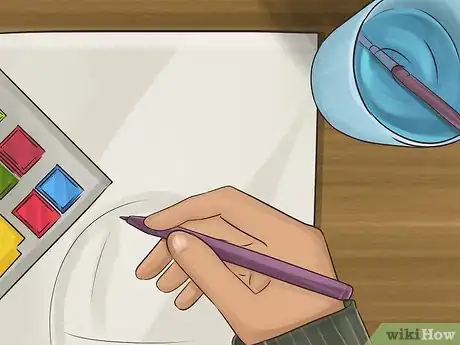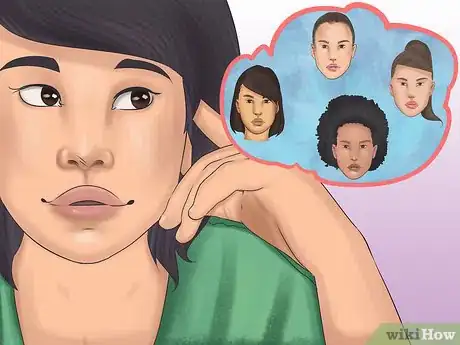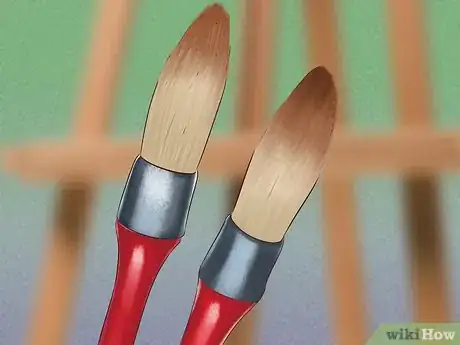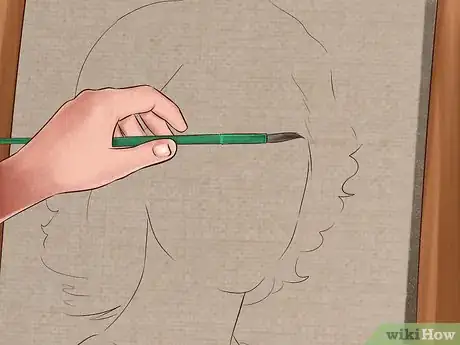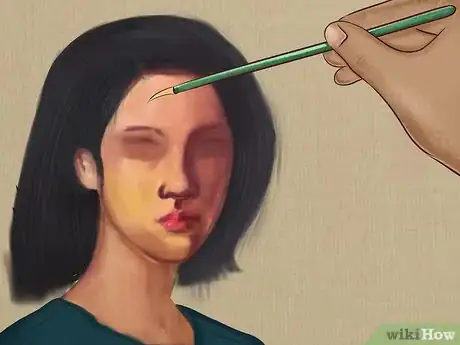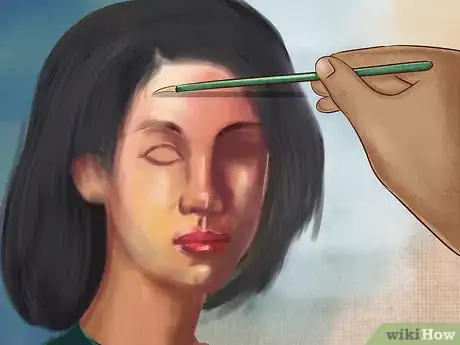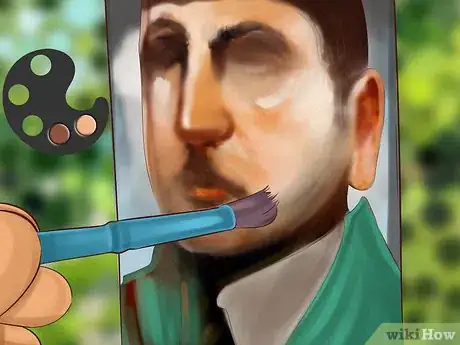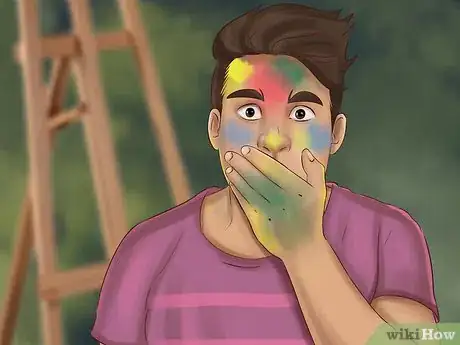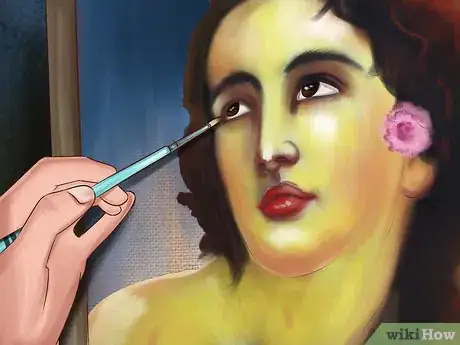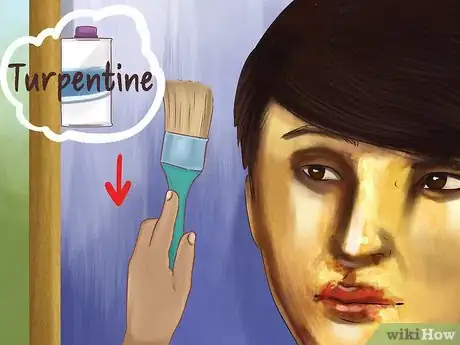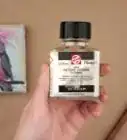This article was co-authored by Veronica Winters. Veronica Winters is a Figurative Artist who owns an online art gallery and studio in Naples, Florida. With over 20 years of experience, Veronica specializes in surreal figurative oil paintings and colored pencil drawings. In 2022, she won the Award for Distinction at the 30th Annual Colored Pencil Society of America International Exhibition. Veronica is also a published author of two art books: How to Color Like an Artist and The Colored Pencil Manual. She received her BFA in Studio Art at Oklahoma State University and her MFA in Painting at Pennsylvania State University. Veronica also studied classical drawing at the Grand Central Academy of Art and the Art Students League of New York.
This article has been viewed 24,809 times.
Oil portraits are a challenge, but you can learn a great deal from each attempt. Since oil paintings take so long to dry, don't hesitate to experiment with many approaches on a single painting.
Steps
Preparing to Paint
-
1Study paintings in an image editing program (optional). Choose a painting of a face that you admire. Load it into Photoshop or another image editor, so you can zoom in and study how the artist created the work.
- Choose pictures or paintings that look straight at you. Any rotation of the head rotates facial features as well which makes it super difficult for beginners to draw out for painting.
- Zoom in so you can see pixels then use the color dropper tool to select various areas of color. This gives you a sense of which colors make up different areas of the face or skin tones.
- Note that your software's color chart will only help you out if you can set it to the RYB color model used in painting.
-
2Prepare a sketch or under painting. To guide your painting, start with a sketch. While practicing, you may want to create a watercolor under painting as well, if the surface is suitable for both watercolor and oil. This will give you a guide for the oil painting process.
- Alternatively, create a fairly light, neutral color mix such as burnt ochre, yellow, and white. Add mineral turpentine until watery, then draft the features onto the canvas. This mix is is transparent and dries quickly, so you can easily paint over it. If you make a mistake, gently dab it away with a dry cloth.
Advertisement -
3Plan out your painting. You don't need to know everything in advance, but get a sense of what the painting will look like. Where is the light coming from? What expression will you paint on the face? Pay special attention to these areas, which are tricky to paint and can drastically change the effect of the painting:
- Position of the nose relative to the eyes, and its contours
- Hair style
- Eyebrows
-
4Mix the skin tones on your palette. To mix a skin tone, try one part carmine red, one part cadmium yellow, and one part ultramarine blue to make brown. Add titanium white gradually until you have the desired color. Use quite a lot of paint, so you have a baseline which you can alter for different parts of the face.
- Too much white can make the skin look grey. If you want a much lighter skin tone, add a little more yellow.
- Oil paints are difficult to mix on the painting without muddying them together. Pre-mix the colors you'll be using on your palette before you begin.
Painting a Face
-
1Use a very small, round brush. This can be made from any material, but a natural sable brush works particularly well for smooth skin textures.
-
2Work with small amounts of paint. Beginning painters often put too much paint on the canvas. Always use just enough paint to cover a small space. This will make it much easier to correct mistakes.
- When you paint a face looking straight at you, make every effort to make it symmetrical.
-
3Start with the dark areas of the painting. Look at your sketch and imagine it as a three dimensional object, with the light coming from a particular direction. The lowest, shadowed areas of the face will use the darkest colors. Start with these, and avoid muddying them with any lighter colors.
-
4Add lighter areas of the face carefully. When painting an elevated, well-lit area of the face, start by placing your lightest color in the center of the area, furthest from the areas of the face that will remain darker.
-
5Blend the light and dark tones together. Clean the brush so there is little to no paint left on it, then gradually work colors together where they border each other.
-
6Create depth by adding layers. To achieve realistic depth, you'll need to layer lighter tones several times. Try working from the outside in on the lighter areas, making each layer smaller and more centralized.
- To emphasize shadows and contours, mix together two complementary colors, plus a little bit of white. (You should get a subtle grey that doesn't overpower your painting.) Apply a tiny bit to the wet paint and blend with your paintbrush.
-
7Don't fuss over small mistakes. Oil paint is a forgiving medium, although it takes a long time to master. You can paint over the same area several times as long as you avoid building it up too thick. More importantly, accept that you will be learning with every painting. Identifying a mistake and an alternate approach is part of the path to improving as a painter.
- If the mistake cannot be fixed by blending, wait patiently for it to dry before you paint over it.
-
8Complete the painting with highlights and shadows. Pure white highlights and pure black shadows improve the contrast of the painting. Add these once you are satisfied with the composition of the painting.
-
9Add a backwash (optional). This is especially useful if you drafted the painting with a turpentine mix, and it ends up visible outside the borders of the face. To cover this, or just for aesthetic effect, mix mineral turpentine into colors of your choice until watery and somewhat transparent. Use a thick brush to apply this to the background, working in downward strokes from the top of the canvas. Never soak the brush or let the mixture drip onto the portrait, as turpentine can wipe away your oil paint.
- Green, turquoise, and blue are common choices for a backwash that makes the face stand out.
Expert Q&A
-
QuestionHow do you make a face with oil paint?
 Veronica WintersVeronica Winters is a Figurative Artist who owns an online art gallery and studio in Naples, Florida. With over 20 years of experience, Veronica specializes in surreal figurative oil paintings and colored pencil drawings. In 2022, she won the Award for Distinction at the 30th Annual Colored Pencil Society of America International Exhibition. Veronica is also a published author of two art books: How to Color Like an Artist and The Colored Pencil Manual. She received her BFA in Studio Art at Oklahoma State University and her MFA in Painting at Pennsylvania State University. Veronica also studied classical drawing at the Grand Central Academy of Art and the Art Students League of New York.
Veronica WintersVeronica Winters is a Figurative Artist who owns an online art gallery and studio in Naples, Florida. With over 20 years of experience, Veronica specializes in surreal figurative oil paintings and colored pencil drawings. In 2022, she won the Award for Distinction at the 30th Annual Colored Pencil Society of America International Exhibition. Veronica is also a published author of two art books: How to Color Like an Artist and The Colored Pencil Manual. She received her BFA in Studio Art at Oklahoma State University and her MFA in Painting at Pennsylvania State University. Veronica also studied classical drawing at the Grand Central Academy of Art and the Art Students League of New York.
Figurative Artist It depends how you want to approach portrait painting, because there are many ways of doing it. In general, if you'd like to learn and follow the classical approach, you must work on your drawing first, then transfer it onto canvas or panel. You can also start drawing directly on canvas with a pencil or even a brush with thin paint.
It depends how you want to approach portrait painting, because there are many ways of doing it. In general, if you'd like to learn and follow the classical approach, you must work on your drawing first, then transfer it onto canvas or panel. You can also start drawing directly on canvas with a pencil or even a brush with thin paint. -
QuestionHow do you paint realistic shadows?
 Veronica WintersVeronica Winters is a Figurative Artist who owns an online art gallery and studio in Naples, Florida. With over 20 years of experience, Veronica specializes in surreal figurative oil paintings and colored pencil drawings. In 2022, she won the Award for Distinction at the 30th Annual Colored Pencil Society of America International Exhibition. Veronica is also a published author of two art books: How to Color Like an Artist and The Colored Pencil Manual. She received her BFA in Studio Art at Oklahoma State University and her MFA in Painting at Pennsylvania State University. Veronica also studied classical drawing at the Grand Central Academy of Art and the Art Students League of New York.
Veronica WintersVeronica Winters is a Figurative Artist who owns an online art gallery and studio in Naples, Florida. With over 20 years of experience, Veronica specializes in surreal figurative oil paintings and colored pencil drawings. In 2022, she won the Award for Distinction at the 30th Annual Colored Pencil Society of America International Exhibition. Veronica is also a published author of two art books: How to Color Like an Artist and The Colored Pencil Manual. She received her BFA in Studio Art at Oklahoma State University and her MFA in Painting at Pennsylvania State University. Veronica also studied classical drawing at the Grand Central Academy of Art and the Art Students League of New York.
Figurative Artist Your reference must have a clear division between light and shade. This means that you want to see strong highlights and very definite shadows on the face. When you follow this breakdown between the light and the shadow, it's easy to paint a realistic portrait even if the colors are not right.
Your reference must have a clear division between light and shade. This means that you want to see strong highlights and very definite shadows on the face. When you follow this breakdown between the light and the shadow, it's easy to paint a realistic portrait even if the colors are not right.

